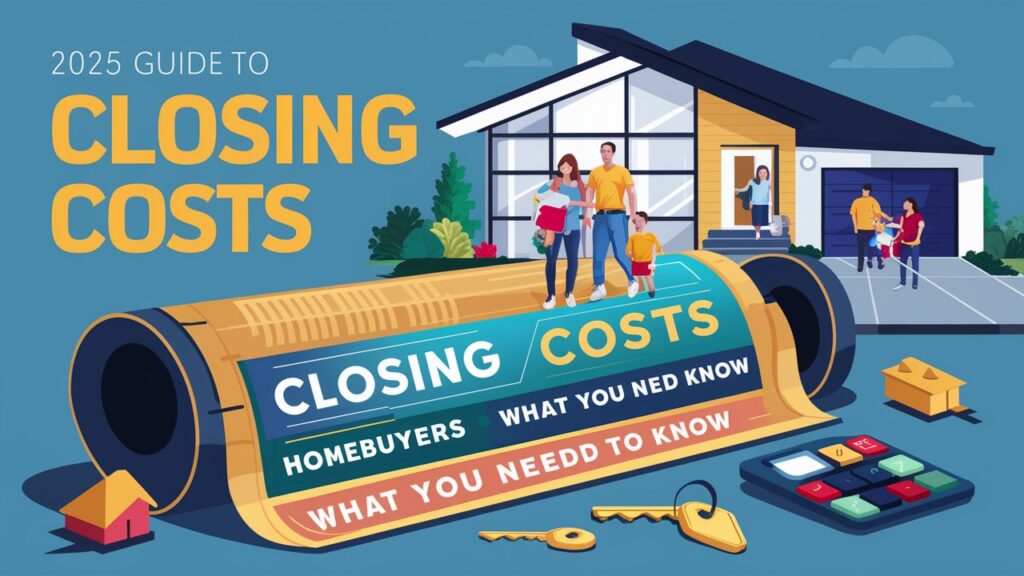Introduction
Closing costs represent one of the most significant—yet least understood—financial components of purchasing a home. These fees, paid at the culmination of a real estate transaction, typically range from 2% to 6% of the loan amount, adding thousands to upfront expenses. For a $400,000 home, this translates to $8,000–$24,000 beyond the down payment 16. Recent regulatory shifts, including the 2024 National Association of Realtors (NAR) settlement, have transformed commission structures and fee transparency, making it essential for buyers to grasp these costs 914. This guide demystifies 2025’s closing costs, offering strategies to navigate and reduce them.
What Are Closing Costs?
Closing costs encompass all fees required to legally finalize a mortgage and transfer property ownership. These expenses cover services from loan origination and title searches to appraisals and government filings. Unlike a down payment, which reduces the loan principal, closing costs are non-equity fees paid to third parties facilitating the transaction. Both buyers and sellers incur closing costs, though their responsibilities differ significantly. For buyers, these fees ensure the property is marketable, the loan is properly underwritten, and their ownership rights are protected. For sellers, costs primarily involve transferring the title and compensating agents 113.
Average Closing Cost Ranges in 2025
In 2025, closing costs average 3–5% of the home’s purchase price, influenced by loan type, location, and property value. According to ClosingCorp data:
- A $300,000 home incurs $6,000–$15,000 in fees.
- High-cost states like New York average $16,849, while Indiana averages $2,200 113.
Table: Average Closing Costs by State (2025)
| State | Avg. Home Price | Avg. Closing Costs |
| District of Columbia | $769,351 | $29,888 |
| California | $793,424 | $7,953 |
| Texas | $302,672 | $4,548 |
| Missouri | <$300,000 | $2,061 |
Government-backed loans add extra fees:
- FHA loans: 1.75% upfront mortgage insurance.
- VA loans: 1.4–3.6% funding fee 113.
Comprehensive Closing Costs Breakdown
Loan-Related Fees
- Origination Fee: 0.5–1% of the loan amount, covering processing and underwriting 16.
- Discount Points: Optional fees (1% of loan per point) to lower interest rates 1015.
- Appraisal Fee: $500–$1,000+ to validate property value 113.
Title and Insurance Fees
- Title Search/Insurance: $300–$2,500+ to verify ownership history and protect against disputes 115.
- Homeowners Insurance: 1 year prepaid (typically $1,000–$4,500) 13.
Prepaid Costs and Escrow
- Property Taxes: Prorated payments based on local rates.
- Escrow Account: 2–8 months of tax/insurance reserves 1215.
Buyer vs. Seller Responsibilities
Buyer-Paid Costs
Buyers cover most lender and property verification fees:
- Loan origination, appraisal, and credit report fees.
- Home inspection ($300–$500) and survey fees ($400+).
- Lender’s title insurance and recording fees ($20–$250) 613.
Seller-Paid Costs
Sellers typically pay:
- Real estate commissions: Historically 5–6%, now negotiable post-NAR settlement 914.
- Transfer taxes and owner’s title insurance (in some states) 613.
Table: Typical Responsibility Breakdown

| Fee Type | Typically Paid By Buyer | Typically Paid By Seller |
| Loan Origination | ✓ | |
| Appraisal | ✓ | |
| Title Insurance | ✓ | ✓ (Owner’s policy) |
| Real Estate Commissions | ✓ | |
| Transfer Taxes | ✓ |
Geographic Variations in Closing Costs
Location dramatically impacts fees:
- High-tax states: New York and Washington, D.C., impose steep transfer taxes, raising costs up to 4.3% of the home price 13.
- Rural areas: USDA loans may waive some fees, but inspection costs rise due to travel surcharges 1.
- Flood zones: Require additional $20 flood certifications 1.
Strategies to Reduce Closing Costs
- Negotiate Seller Concessions:
Sellers can cover up to 9% of costs (conventional loans) or 6% (FHA) via concessions 613. - Shop for Services:
Compare title insurance, inspection, and attorney fees—services buyers can choose 610. - Lender Credits or No-Closing-Cost Mortgages:
Accept a slightly higher interest rate in exchange for reduced upfront fees 1015. - Grants and Assistance Programs:
Programs like Bank of America’s Community Homeownership Commitment® offer up to $17,500 in down payment and closing cost aid 412.
Understanding Loan Estimates and Closing Disclosures
Within three days of applying, lenders provide a Loan Estimate (LE), detailing projected closing costs. Key features:
- Shoppable vs. Non-Shoppable Fees: Appraisal fees are fixed; title insurance can be compared 115.
- Closing Disclosure (CD): Received three days pre-closing, this final document must closely mirror the LE. Legally, total costs cannot exceed the LE by >10% 16.
Payment Methods for Closing Costs
- Out-of-Pocket: Ideal for buyers seeking long-term savings.
- Financed Costs: Roll fees into the loan (increases principal and interest) 1013.
- Seller Credits: Deducted from the seller’s proceeds at closing.
Frequently Asked Questions
- What percentage of the home price are closing costs?
Typically 2–6%, varying by loan type and location. For a $500,000 home, expect $10,000–$30,000 113. - Can closing costs be included in the mortgage?
Yes, via “no-closing-cost” loans, but this increases your loan balance or interest rate 10. - Are closing costs negotiable?
Partially. Lender fees (origination) and real estate commissions are negotiable; government fees are fixed 613. - Who pays more: buyer or seller?
Sellers typically pay more (up to 10% of sale price, mainly commissions). Buyers pay 2–6% in lender and property fees 13. - When are closing costs due?
Paid at closing via wire transfer or certified check 115.
Conclusion
Closing costs remain a non-negotiable pillar of homebuying, but 2025’s evolving regulations and negotiation avenues offer unprecedented opportunities for savings. By scrutinizing Loan Estimates, leveraging seller concessions, and tapping assistance programs, buyers can turn these fees from a burden into a manageable investment. As the NAR settlement reshapes commission norms, proactive buyers stand to gain the most—transparency is now your greatest ally.


